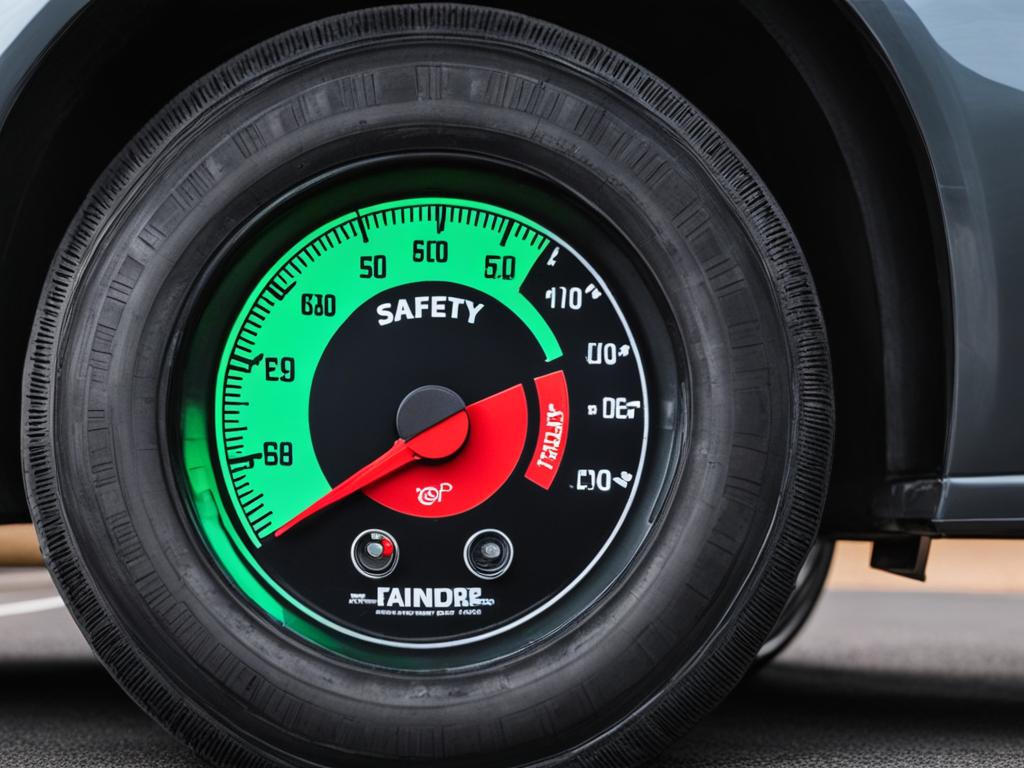Reset Tire Pressure Light on Honda Accord Easily
If you’re experiencing the issue of the tire pressure light on your Honda Accord not turning off even after inflating your tires, you’re not alone. This is a common problem among Honda owners, but the good news is that it’s relatively easy to reset the TPMS light on your Honda Accord. Whether you have a newer model with a touchscreen display or an older model with steering wheel buttons, we’ll walk you through the step-by-step process to recalibrate your TPMS system and get rid of that annoying light.
Key Takeaways:
- Resetting the tire pressure light on your Honda Accord is a simple process.
- Both newer and older Honda Accord models have different methods for resetting the TPMS light.
- Proper tire pressure is crucial for safety and performance.
- If the TPMS light keeps flashing, it indicates a system malfunction that should be addressed by a professional.
- Troubleshooting tips can help resolve common TPMS issues.
Resetting TPMS in New Honda Vehicles
If you have a newer Honda Accord model with a touchscreen display, the TPMS reset process is quite simple. Follow these steps to reset the TPMS light:
- From the home screen, navigate to the settings menu.
- Select the vehicle option.
- Find the TPMS Calibration option.
- Select Calibrate to initiate the recalibration process.
By following these steps, you can reset the TPMS light on your Honda Accord and ensure that your tire pressure is accurately monitored. Remember to check your tire pressure regularly to maintain optimal safety and performance.
Table: Common TPMS Reset Methods for Honda Accord
| Model Type | Reset Method |
|---|---|
| Newer Models with Touchscreen Display | Navigate to settings menu > vehicle > TPMS Calibration > Calibrate |
| Older Models without Touchscreen Display | Press menu button > settings menu > TPMS Calibration > Initialize or Calibrate |
Resetting TPMS in Older Honda Vehicles
If you own an older Honda Accord model without a touchscreen display, you may need to utilize the steering wheel buttons to reset the TPMS (Tire Pressure Monitoring System).
Here is a step-by-step guide to help you reset the TPMS light on your older Honda Accord:
- Locate the menu button on your steering wheel. It’s usually located on the left side, near the top.
- Press the menu button to access the settings menu on your instrument cluster.
- Use the navigation buttons on your steering wheel to scroll through the settings menu and find the TPMS Calibration option.
- Select the TPMS Calibration option.
- Choose “Initialize” or “Calibrate” to initiate the TPMS reset process.
Some older Honda Accord models may have a dedicated TPMS button instead of going through the menu. If your Honda Accord has this feature, simply press the TPMS button to reset the TPMS light.
By following these steps, you should be able to reset the TPMS light on your older Honda Accord and ensure accurate tire pressure monitoring.

Having trouble resetting the TPMS light? Don’t worry. Take a look at the troubleshooting section below for further assistance.
What to Do If TPMS Light Keeps Flashing
If the TPMS warning light continues to flash every time you start your Honda Accord, it’s essential to take action. This persistent flashing indicates a malfunction in the TPMS system, which requires attention to ensure your safety on the road. Ignoring the flashing TPMS light can result in inaccurate tire pressure readings and compromised driving performance.
There are a few possible reasons why the TPMS light may keep flashing:
- Tire or wheel replacement: If you recently had a tire or wheel replaced, it’s possible that the TPMS sensor wasn’t properly installed or calibrated. This can trigger the TPMS light to continuously flash.
- Faulty TPMS sensor: A malfunctioning TPMS sensor can also cause the light to flash. Over time, these sensors may experience wear and tear, leading to inaccurate readings and signal transmission.
- Electrical issue: In some cases, an electrical problem within the TPMS system can trigger the flashing light. This could be due to a faulty wiring connection or a more complex issue that requires professional diagnosis.
If you’re experiencing a flashing TPMS light, it’s recommended to visit a Honda service center to have the issue diagnosed and fixed by a professional technician. They have the expertise and specialized equipment to identify the exact cause of the problem and provide appropriate solutions.
By addressing the root cause of the flashing TPMS light, you can ensure that your Honda Accord’s TPMS system is functioning correctly, providing accurate tire pressure readings and promoting optimal driving performance. Remember, a properly calibrated TPMS system plays a crucial role in maintaining your vehicle’s safety and efficiency.
Possible Causes of TPMS Light Flashing
| Cause | Description |
|---|---|
| Tire or wheel replacement | Improper installation or calibration of TPMS sensor after tire or wheel replacement. |
| Faulty TPMS sensor | Malfunctioning TPMS sensor causing inaccurate readings and signal transmission. |
| Electrical issue | Electrical problem within the TPMS system, such as faulty wiring or other complex issues. |
As seen in the table above, there are several possible causes for a flashing TPMS light. It’s crucial to address the issue promptly to ensure the proper functioning of your TPMS system and maintain safe driving conditions.
Troubleshooting TPMS System Issues
Sometimes, issues with the TPMS system can arise, such as the tpms light came on and turned itself off or the tpms light not turning off after filling tire. While these situations can be frustrating, there are steps you can take to troubleshoot and resolve these problems.
First, it’s important to check the tire pressure again to ensure that it matches the recommended level for your Honda Accord. Use a reliable tire pressure gauge to measure the pressure of each tire, including the spare tire if you have one. If any tire is significantly underinflated or overinflated, adjust the pressure accordingly.
Next, it’s recommended to drive the vehicle at a speed over 28 miles per hour for a few minutes. This allows the TPMS system to update and recalibrate itself. Sometimes, the system needs this motion to detect the correct tire pressure and turn off the TPMS light.
If the problem persists and the TPMS light continues to stay on, it may be necessary to consult a mechanic who specializes in automotive electronics and TPMS systems. They have the knowledge and diagnostic tools to identify any underlying issues with the TPMS system and provide the necessary repairs.
“The TPMS system is designed to alert you when there is a significant change in tire pressure, which is crucial for your safety on the road. If you’re experiencing issues with the TPMS light, taking the appropriate troubleshooting steps is essential.”
By following these troubleshooting steps, you can address common TPMS system issues and ensure proper functionality. It’s important to prioritize the maintenance and proper functioning of your TPMS system to keep yourself and your Honda Accord safe on the road.

Summary:
- Check the tire pressure again to ensure it matches the recommended level
- Drive the vehicle at a speed over 28 miles per hour for a few minutes
- If the TPMS light persists, consult a mechanic
Importance of Proper Tire Pressure
Maintaining proper tire pressure is crucial for your safety and the performance of your Honda Accord. Your vehicle’s tires are its only point of contact with the road, and their condition directly affects how your car handles, brakes, and accelerates.
Underinflated tires pose serious hazards on the road. When your tires are not inflated to the recommended pressure, several negative effects can occur:
- Increased heat generation: Underinflated tires cause excessive heat buildup due to increased friction. This can lead to tire blowouts, especially in hot weather or during extended periods of driving.
- Faster degeneration: Insufficient air pressure causes the tire to wear out more quickly, reducing its lifespan and requiring more frequent replacements.
- Decreased fuel economy: Underinflated tires create higher rolling resistance, resulting in decreased fuel efficiency. This means you’ll have to spend more money at the gas pump.
- Compromised steering and handling: When tire pressure is too low, your vehicle’s handling and responsiveness suffer. It becomes more difficult to steer accurately, especially during quick maneuvers or emergency situations.
To ensure optimal safety and performance on the road, it’s important to regularly check and maintain the recommended tire pressure for your Honda Accord. By doing so, you can avoid the hazards associated with underinflated tires and enjoy a smoother, more efficient driving experience.
“Proper tire pressure is not only essential for your safety, but it also affects your vehicle’s overall performance. Don’t underestimate the importance of maintaining the right tire pressure.”

Tire Pressure Recommendations
The recommended tire pressure for your Honda Accord can be found in your vehicle’s owner’s manual or on a sticker located on the driver’s side door jamb or inside the fuel filler flap. Make sure to follow the manufacturer’s guidelines for the specific make, model, and tire size of your Honda Accord.
Conclusion
Resetting the tire pressure light on your Honda Accord is a straightforward process that can be done using either the touchscreen display or the steering wheel buttons, depending on the model of your vehicle. By following the step-by-step instructions outlined in this article, you can easily recalibrate your TPMS system and ensure that the tire pressure light is no longer illuminated. Remember, maintaining proper tire pressure is essential for both your safety and the overall performance of your Honda Accord.
Regularly monitoring and maintaining the recommended tire pressure will contribute to optimal safety on the road. Underinflated tires can lead to increased heat generation, faster tire wear, reduced fuel efficiency, and compromised steering and handling. By resetting the tire pressure light and keeping your tires properly inflated, you can minimize these risks and ensure that your Honda Accord performs at its best.
If you encounter any issues with the TPMS system, such as the light coming on and then turning off on its own or the light remaining illuminated even after inflating the tires, it is recommended to check the tire pressure again and drive the vehicle at a speed over 28 miles per hour for a few minutes. This will allow the TPMS system to update and may resolve the issue. However, if the problem persists, it is advisable to consult a qualified mechanic or visit a Honda service center for further assistance.
FAQ
How do I reset the tire pressure light on my Honda Accord?
To reset the tire pressure light on your Honda Accord, you can use either the touchscreen display or the steering wheel buttons, depending on the model of your vehicle. Refer to the specific instructions provided in Section 2 for newer Honda vehicles or Section 3 for older Honda vehicles to recalibrate the TPMS system and turn off the tire pressure light.
How do I reset the TPMS in a newer Honda Accord model with a touchscreen display?
In newer Honda Accord models with a touchscreen display, you can reset the TPMS by navigating to the settings menu, selecting the vehicle option, and choosing the TPMS Calibration option. Then, select “Calibrate” to initiate the recalibration process. For a detailed step-by-step guide, please refer to the instructions provided in Section 2.
How do I reset the TPMS in an older Honda Accord model without a touchscreen display?
If you have an older Honda Accord model without a touchscreen display, the TPMS reset process may require the use of steering wheel buttons. By pressing the menu button and navigating to the settings menu, you can find the TPMS Calibration option and select “Initialize” or “Calibrate” to reset the TPMS light. Some older models may even have a dedicated TPMS button to make the process even easier. Please refer to Section 3 for specific instructions on resetting the TPMS in older Honda vehicles.
What should I do if the TPMS warning light continues to flash on my Honda Accord?
If the TPMS warning light continues to flash every time you start your Honda Accord, it indicates a malfunction in the system. This could be caused by a tire or wheel replacement that was not done correctly. In this case, it’s best to visit a Honda service center to have the issue diagnosed and fixed by a professional. For more information, please see Section 4.
What should I do if the TPMS light on my Honda Accord comes on and then turns off on its own?
If the TPMS light comes on and then turns off on its own, it could be an indication of an intermittent issue with the TPMS system. In such cases, it’s recommended to check the tire pressure again, drive the vehicle at a speed over 28 miles per hour for a few minutes to allow the TPMS to update, or consult a mechanic if the problem persists. See Section 5 for troubleshooting tips.
Why is maintaining proper tire pressure important for a Honda Accord?
Maintaining proper tire pressure is crucial for your safety and the performance of your Honda Accord. Underinflated tires can lead to increased heat generation, faster degeneration, decreased fuel economy, and compromised steering and handling. Regularly checking and maintaining the recommended tire pressure ensures optimal safety and performance on the road. Find more details on the importance of proper tire pressure in Section 6.




